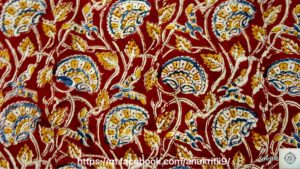
There are two distinctive styles of kalamkari art in India – the Srikalahasti style and the Machilipatnam style. The Srikalahasti style of kalamkari, wherein the “kalam” or pen is used for free hand drawing of the subject and filling in the colors, is entirely hand worked. This style flowered around temples and their patronage and so had an almost religious identity – scrolls, temple hangings, chariot banners and the like, depicted deities and scenes taken from the Hindu epics – Ramayana, Mahabarata, Puranas and the mythological classics. This style owes its present status to Kamaladevi Chattopadhayay who popularized the art as the first Chairperson of the All India Handicrafts Board. Only natural dyes are used in kalamkari and it involves seventeen step
History
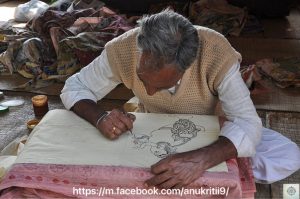
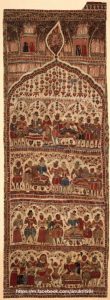
Kalamkari wall hanging, early 17th century.
In ancient times, groups of singers, musicians and painters, called chitrakattis, moved village to village to tell the village dwellers, the great stories of Hindu mythology. They illustrated their accounts using large bolts of canvas painted on the spot with simple means and dyes extracted from plants. In the same way, one found in the Hindu temples large panels of kalamkari depicting the episodes of Indian mythology, similar to the stained glasses of the Christian cathedrals.
As an art form it found its peak in the wealthy Golconda sultanate, Hyderabad, in the Middle Ages. The Mughals who patronized this craft in the Coromandel and Golconda province called the practitioners of this craft “qualamkars”, from which the term “kalamkari” evolved.[1]
Kalamkari art has been practiced by many families in Andhra Pradesh and over the generations has constituted their livelihood. Kalamkari had a certain decline, then it was revived in India and abroad for its craftsmanship. Since the 18th century the British liked the decorative element for clothing.
Modern forms
in modern times the term is also used to refer, incorrectly, to the making of any cotton fabric patterned through the medium of vegetable dyes by free-hand painting and block-printing, produced in many different regions of India. In places where the fabric is block printed the kalam (pen) is used to draw finer details and for application of some colours
Srikalahasthi process
At Srikalahasthi, the real craft that has existed since its birth was our next aim and we were eagerly waiting to explore it. The real magic of holding a kalam and doing kalamkari was hidden here at Srikalahasti. Almost the whole process of kalamkari at both the places was same but the major difference was the printing process. At machilipatnam, the printing is done using blocks, but at Srikalahasti the printing work is done by using a kalam.
MAKING OF KALAM

The kalam is made by using bamboo sticks. It is sharpened by using a cutter. The kalam is sharpened from the top so as the color can drip from it and it leaves precise fine lines on the cloth. A woollen cloth or a cotton rug or foam is tied with a thread on the pen from where it is holed.
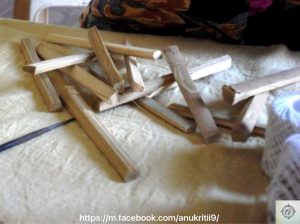


PRINTING PROCESS
The printing is done by kalam; which needs to be soaked in the colour for about 10 minutes before any printing is done. The cloth rug which is tied to the kalam needs to be pressed gently and the kalam needs to be drawn smoothly without any breakage and stoppage while working on the cloth so as to get perfect lines without any extra dripping or blots of the colour. The first printing includes the application of black and red colour only.
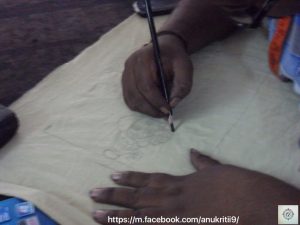
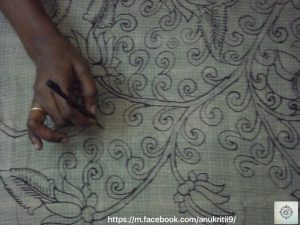

WASHING AND BOILING
After the first printing dries off; the cloth needs to be washed properly for 15-20 minutes under running water. And while washing the cloth one has to make sure that the cloth stays inside the water and does not comes up on the surface otherwise the printing may smudge a bit. As soon as the washing is done, the cloth is dipped in a vessel inside which water is boiled. The cloth needs to be boiled in the water for about 10 minutes. After the boiling is over, the cloth needs to be dried in the sun.
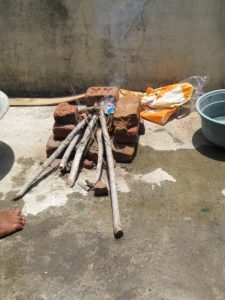
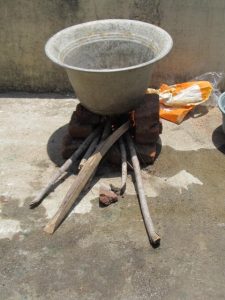
MILKING PROCESS
After the cloth is dried, the cloth needs to be soaked in cow milk for almost 4-5 hours. After the milking process, the cloth is dried again. The milking process is necessary for the second and third printing because after the milking is done, and when the color is applied it does not blots.
SECOND AND THIRD PRINTING
The second printing is done by using yellow color. After 3-4 hours when the yellow color dries up, the third printing colors i.e. pink, blue and green are applied.


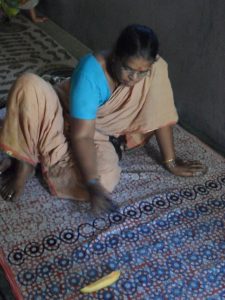
FINAL WASHING
After all the printing is finished, the cloth is again washed finally and dried in sun. after this the cloth is sent for finishing and is ready as a finished product.
Design in kalamkari
